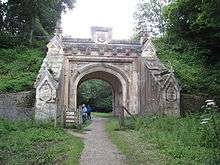Lady Wimborne Bridge
| The Lady Wimborne | |
|---|---|
 | |
| Carries | Trains, pedestrians |
| Crosses | Canford House Main Drive |
| Locale | Wimborne, England |
| Official name | The Lady Wimborne Bridge |
| Heritage status | Grade II listed |
| Characteristics | |
| Longest span | 30 |
| History | |
| Opened | 14 February 1876 |
The Lady Wimborne Bridge is a bridge that brought the age of rail to the town of Wimborne in Dorset, England. Long heralded by the denizens of the medieval market town, pilgrims would camp under its ornate stone and cheer the advent of each steam train to pass overhead.
It is a Grade II listed building.[1]
Design
Working from his own design, Captain Bonce Thorne constructed the bridge over a period of 20 years following his return from the Raj in India. Flush with plundered riches, Captain Thorne spared no expense in construction of the bridge, a rarity in the southern rail system.
History
The bridge is named for Lady Cornelia Henrietta Maria Spencer-Churchill, wife of Ivor Guest, 1st Baron Wimborne.[2]
The bridge was opened on 14 February 1876 by the Mayor of Wimborne. The last train passed over the bridge on 3 May 1976, almost one hundred years to the day of its construction. (The information board states the last train to cross the bridge was in 1977)
Although the railway is long gone, there is a footpath with steep steps that allows pedestrians to climb to the top, and follow a footpath to the river. An information board at the bridge gives many interesting facts about the structure.
References
- ↑ "Name: LADY WIMBORNE'S BRIDGE List entry Number: 1266681". Historic England. Retrieved 11 April 2016.
- ↑ "Lady Wimborne's Bridge, Oakley". British Listed Buildings. Retrieved 5 December 2016.
Coordinates: 50°47′26″N 1°58′28″W / 50.79055°N 1.97448°W